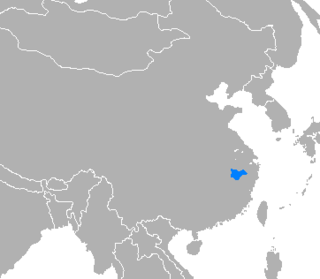Huizhou Chinese (Chinese: 徽州话), or the Hui dialect (Chinese: 徽语), is a group of closely related Sinitic languages spoken over a small area in and around the historical region of Huizhou (for which it is named), in about ten or so mountainous counties in southern Anhui, plus a few more in neighbouring Zhejiang and Jiangxi.
| Huizhou | |
|---|---|
| 徽州話 / 徽州话 | |
| Native to | China |
| Region | Huizhou, southern Anhui, neighbouring portions of Zhejiang and Jiangxi |
Native speakers | 5.4 million (2021)[1] |
| Language codes | |
| ISO 639-3 | czh |
| Glottolog | huiz1242 |
| Linguasphere | 79-AAA-da |
 | |
| Huizhou Chinese | |||||||||||||||||||||||||||
|---|---|---|---|---|---|---|---|---|---|---|---|---|---|---|---|---|---|---|---|---|---|---|---|---|---|---|---|
| Simplified Chinese | 徽州话 | ||||||||||||||||||||||||||
| Traditional Chinese | 徽州話 | ||||||||||||||||||||||||||
| Hanyu Pinyin | Huīzhōuhuà | ||||||||||||||||||||||||||
| |||||||||||||||||||||||||||
| Alternative Chinese name | |||||||||||||||||||||||||||
| Simplified Chinese | 徽语 | ||||||||||||||||||||||||||
| Traditional Chinese | 徽語 | ||||||||||||||||||||||||||
| Hanyu Pinyin | Huīyǔ | ||||||||||||||||||||||||||
| |||||||||||||||||||||||||||
Although the Hui area is small compared with other Chinese dialect groups, it displays a very high degree of internal variation. Nearly every county has its own distinct dialect unintelligible to a speaker from a few counties away. For this reason, bilingualism and multilingualism are common among speakers of Hui. It is estimated that there are around 4.6 million speakers of Huizhou varieties.[citation needed]
Classification
Huizhou Chinese was originally classified as Lower Yangtze Mandarin but it is currently classified separately from it.[2]The Chinese Academy of Social Sciences supported the separation of Huizhou from Lower Yangtze Mandarin in 1987.[3] Its classification is disputed, with some linguists, such as Matisoff classifying it as Wu Chinese, others such as Bradley (2007) as Gan, and still others setting it apart as a primary branch of Chinese.
History
During the Ming and Qing dynasties, Jianghuai speakers moved into Hui dialect areas.[4]
Some works of literature produced in Yangzhou, such as Qingfengzha, a novel, contain Jianghuai Mandarin. People in Yangzhou identified by the dialect they speak, locals spoke the dialect, as opposed to sojourners, who spoke other varieties like Huizhou or Wu. This led to the formation of identity based on one's dialect. Large numbers of merchants from Huizhou lived in Yangzhou and effectively were responsible for keeping the town afloat.[5] Merchants in the later imperial period also sponsored operas and performances in the Hui dialect.[6]
Languages and dialects
Zhengzhang Shangfang divided the Hui languages into five subgroups, which are also used in the Language Atlas of China:[7][8]
- Ji–She (績歙)
- spoken in Jixi, She County, Huizhou, Jingde (Hongchuan area in the west), and Ningguo (Hongmen area in the south), Anhui province, as well as Chun'an (Tangcun in the west, etc.), Zhejiang province.
- carries notable Wu influence. Jixihua is the main Ji-She variety.
- Xiu–Yi (休黟)
- spoken in Tunxi, Taiping (Guocun in the southwest), Xiuning, Yi County, and Qimen (around Fufeng in the southeast), as well as Wuyuan, Jiangxi province.
- Tunxihua is the main Xiu-Yi variety.
- Qi–De (祁德)
- spoken in Qimen and Dongzhi (partially), Anhui province, as well as Fuliang, Dexing, and Wuyuan, Jiangxi province.
- greatly influenced by the surrounding Gan languages.
- Yanzhou (嚴洲)
- spoken in Chun'an and Jiande (formerly Yanzhou Prefecture), Zhejiang province.
- heavily influenced by Wu.
- Jing–Zhan (旌占)
- spoken in Jingde, Qimen (in and around Anling, Chengan, and Chiling), Shitai (Zhanda area), Yi County (Meixi, Kecun, and other northern towns), and Ningguo, Anhui province.
- forms a thin corridor along the northern edge of the Hui group, carrying influence from Xuanzhou Wu.
Huizhou varieties differ from township to township.[9] People in different townships, towns, etc. (even in one county) often cannot speak with one another.
Features
Phonologically speaking, Hui is noted for its massive loss of syllable codas, including -i, -u, and nasals:
| Character | Meaning | Hui of Tunxi | Wu of Shanghai | Huai (Jianghuai) of Hefei | Mandarin of Beijing |
|---|---|---|---|---|---|
| 燒 | burn | /ɕiɔ/ | /sɔ/ | /ʂɔ/ | /ʂɑu/ |
| 柴 | firewood | /sa/ | /za/ | /tʂʰɛ/ | /tʂʰai/ |
| 綫 | line | /siːɛ/ | /ɕi/ | /ɕĩ/ | /ɕiɛn/ |
| 張 | sheet | /tɕiau/ | /tsɑ̃/ | /tʂɑ̃/ | /tʂɑŋ/ |
| 網 | web | /mau/ | /mɑ̃/ | /wɑ̃/ | /wɑŋ/ |
| 檻 | threshold | /kʰɔ/ | /kʰɛ/ | /kʰã/ | /kʰan/ |
Many Hui dialects have diphthongs with a higher lengthened first part. For example, 話 ("speech") is /uːɜ/ in Xiuning County (Standard Chinese /xuɑ/), 園 ("yard") is /yːɛ/ in Xiuning County (Standard Chinese /yɛn/); 結 ("knot") is /tɕiːaʔ/ in Yi County (Standard Chinese /tɕiɛ/), 約 ("agreement") is /iːuʔ/ in Yi County (Standard Chinese /yɛ/). A few areas take this to extremes. For example, Likou in Qimen County has /fũːmɛ̃/ for 飯 ("rice") (Standard Chinese /fan/), with the /m/ appearing directly as a result of the lengthened, nasalized /ũː/.
Because nasal codas have mostly been lost, Hui reuses the 儿 /-r/ ending as a diminutive. For example, in the Tunxi dialect, 索 "rope" appears as /soːn/ from /soʔ/ + /-r/.
